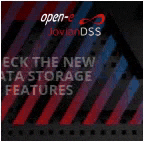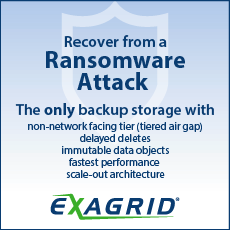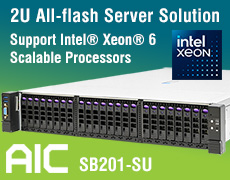IBM 1U FlashSystem 5300 Entry-Level All-Flash Storage Platform
Up to 1.81PB of data (effective capacity) using 2:1 de-due and 3:1 compression ratio
This is a Press Release edited by StorageNewsletter.com on May 1, 2024 at 2:01 pm![]()
By Sam Werner, VP, storage product management, IBM Corp.
IBM Corp. announced the FlashSystem 5300, an entry-level storage solution that delivers price performance, HA, and enterprise-class data services to all sizes of businesses in 1-rack unit.
For organizations challenged with resource constrained data centers and large demanding workloads, the FlashSystem 5300 is a scalable all-flash primary storage platform that offers flexibility to clients of all sizes when choosing the performance and capacity characteristics for their latency-sensitive workloads and highly volatile data sets. Now, clients can also take advantage of additional FlashSystem 5300 benefits via the new IBM Storage Assurance program, also announced, to support a strategy for their storage architectures to get more out of their data center investments.
“AI and ransomware protection are top priorities for clients of all sizes,” said Dave Pearson, research VP, infrastructure systems, IDC. “With recently improved performance and IBM FlashCore Module ransomware detection, FlashSystem 5300 aims to address these critical business needs for clients modernizing their hybrid cloud storage.”
Unlike traditional vendors who invest in monolithic storage systems, the FlashSystem 5300 is designed to protect and consolidate workloads into a small footprint – 1U of a standard rack – for a larger performance and capacity envelope.
This model delivers improvements in performance, capacity, and data resilience, including:
- Improved productivity: For similarly configured systems running a typical enterprise workload, like a database, the FlashSystem 5300 is designed to deliver up to 45% more throughput on a 70/30/50 typical production workload [1], like a database, and at least a 50% bandwidth improvement on sequential workloads versus the previous-gen FlashSystem 5200. [2]
- Increased storage density: Clients can get up to 1.81PB of data (effective capacity) in a fully populated 1U form factor system, using 2:1 de-dupe and 3:1 compression ratio. [3] Also, the FlashSystem 5300 can deliver up to 1.81PB of data (effective capacity) in a fully populated 1U form factor system, using 2:1 de-dupe and 3:1 compression ratio. [4]
- Enhanced data resilience: New technology enabled by FlashCore Module 4 is designed to continuously monitor statistics gathered from I/O using ML models to detect anomalies like ransomware in less than a minute.[5]
- Maximized efficiency: Clients can leverage AI-powered predictive analytics with IBM Storage Insights, Spectrum Virtualize which includes AI-based data placement, and automation.
-
Enhanced VMware Integrations: Protect VMs from threats with immutable snapshot support, policy-based replication, and VMware VM 2.0 support.
With its compact footprint and improved storage density, the FlashSystem 5300 provides a building block that organizations can leverage to start small and then scale up – both performance and capacity – as their business needs evolve.
Both the IBM Storage Assurance program and the FlashSystem 5300 are generally available.
More in store with our business partners
The company work closely with its business partners to offer solutions to clients of all sizes looking to bring simplicity to their IT stack while prioritzing performance and scale. The goal of our business partners is to help organizations get additional value from the firm’s FlashSystems by setting up defenses to detect threats as quickly as possible, with improved operational security capabilities that aid in understanding attack surfaces.
Here is what partners have to say:
“With the enhancements brought into the IBM Flash System 5300, IBM have improved an already great product. Higher capacity, faster performance and more throughputs are great improvements. The FS5300, when combined with the new Flash Core Module Gen 4 also delivers on compression and security. Looking forward to seeing how these enhancements compare to their predecessors,” said Steve Jeffery, business development manager, Arrow.
“For over 10 years, we have relied on IBM’s FlashSystem technology, which has been a true game-changer. Now, with the release of the new IBM FlashSystem 5300, I am excited to see even greater performance, capacity, and data resiliency enhancements. I am confident that this new technology will help organizations get the most out of their data center investments,” said Zoran Ilić, sales manager, Axians.
“Integrating IBM’s FlashSystem into our Cegeka Power Cloud architecture has significantly elevated our operational efficiency and scalability. This system not only meets our immediate needs with its cost-effective and flexible solutions but also aligns perfectly with our long-term vision for a resilient and powerful hybrid cloud infrastructure. The advancements in performance, capacity, and cyber-resilience of the new 5300 model empower us to leverage leading-edge technology, accelerating data access, enhancing reliability, and ensuring seamless customer experiences, while securely fortifying our data,” said Gert-Jan Vaes, manager services, Cegeka.
“Using the IBM FlashSystem 5000 technology is easy and simple to install. We are excited to show our customers the new FlashSystem 5300 and its improved cyber resilience capabilities, all within a 1U footprint. It is amazing to think of the high performance, increased capacity, and enterprise-grade features users will be able to access at this price point,” said Michael Schroll, IBM practice manager, Technologent.
[1] Performance metrics based on internal IBM testing of a FlashSystem 5300 with 12 FlashCore Modules, 512GB cache, 16x32Gb FC ports. And a FlashSystem 5200 with 12 FlashCore Modules, 512GB cache, 8x32Gb FC ports. FS5200 delivered 270,944 IOs at 1.00ms latency on 16KB block size random 70/30/50 workload while the FS5300 delivered 394,955 IOPS on the same workload (45% improvement). Results may vary.
[2] Performance metrics based on internal IBM testing of a FlashSystem 5300 with 12 FlashCore Modules, 512GB cache, 16x32Gb FC ports. And a FlashSystem 5200 with 12 FlashCore Modules, 512GB cache, 8x32Gb FC ports. FS5200 delivered 17.8GB/s on 256KB block size, sequential read hit workload while the FS5300 delivered 28.6GB/s on the same workload. Results may vary.
[3] 1U control enclosure: 12 drives of 38.4TB each = 460.8 TB configured in a 9+Q+P+S DRAID-6 array, after RAID overhead and metadata provisioning, deliver 302.12TB of usable capacity, with a 3:1 compression and 2:1 de-dupe ratio equal 1.81PB of effective capacity.
[4] Two 5U expansions: 92 drives 30.72TB + one 2U expansion: 24 drives 1.92TB configured in a 10+P+Q+S DRAID-6 array, after RAID overhead and metadata provisioning, deliver 3,952.68TB of usable capacity + 1U control enclosure: 12 drives of 38.4TB each configured in a 9+Q+P+S DRAID-6 array, after RAID overhead and metadata provisioning, deliver 302.12TB of usable capacity. A total of 4,254.8TB of usable capacity with a 3:1 compression and 2:1 de-dupe ratio equal 25,528.80TB of effective capacity in 13U of a standard rack.
[5] Internal experimentation by IBM Research has demonstrated detection of ransomware within 1mn of the ransomware starting its encryption process. This experiment was done on a FlashSystem 5200 with 6 FCMs with the 4.1 firmware load. The 5200 had 8.6.3 GA level software loaded. The host connected to the 5200 was running Linux with XFS Filesystem. In this particular case, the IBM ransomware simulator called WannaLaugh was used. Underlying system must be compatible with FCM4.1 and version 8.6.3 GA level software loaded in order to receive results obtained.















 Subscribe to our free daily newsletter
Subscribe to our free daily newsletter

